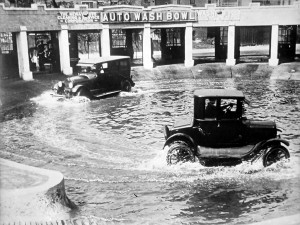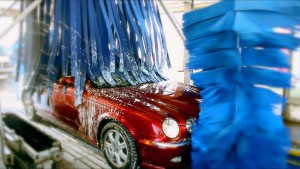The latest electronic safety systems are doing a great job curbing crashes on the highway, but they’re also creating some headaches when it’s time to get your car washed, it seems.
That automatic emergency braking, or AEB, system that can prevent a rear-end collision just might also prevent your car from moving through a car wash tunnel, according to a report published by car buying website bestride.com.
Radar and cameras sensors can mistake the brushes inside a car wash for another vehicle and jam on the brakes, the report said, pointing to 33 different vehicles from 14 brands it found had problems. But the issue could get more severe in the coming years as more models adopt the technology.
“Collision detection, auto hold braking and other technologies are coming to every car as standard equipment by 2020,” noted BestRide Editor-in- chief Craig Fitzgerald. “Consumers have no idea about the unintended consequences of these technologies on simple, everyday tasks. We want drivers to be informed before they get to the car wash.”
(New high-tech safety systems “APEAL” to motorists, says JD Power. Click Here to see why.)
A growing number of vehicles already come equipped with forward warning systems designed to alert a motorist to a possible collision. Many also offer AEB, a more advanced version of the technology that can actually brake a vehicle automatically if the driver doesn’t respond to an initial warning.
While some vehicles can tell the difference between an obstacle on the highway and the brushes in a car wash, others confuse the two.
The problem is severe enough that the International Car Wash Association has published a list of “Special Needs Vehicles” that could cause problems for its member businesses – including guidelines on how to deal with the issue.
The list of brands includes mainstream marques like Dodge, Ford and Toyota, as well as upscale makers like Acura, BMW, Infiniti and Mercedes-Benz. Owners of vehicles with these advanced safety systems should check their manuals to see if there could be a problem and, if necessary, deactivate the systems before the vehicles go through a car wash.
(NHTSA releases first federal guidelines for autonomous vehicles. Click Here for more.)
The new BMW 7-Series manual specifically warns drivers what to do “before driving into a car wash.” But the trade association also noted there are no cutoff instructions for some brands, including Mercedes.
In most cases, the safety systems will automatically reactivate when a vehicle is shut off and restarted. So, motorists might want to briefly turn their cars off after exiting the car wash tunnel.
Industry officials and safety experts insist the benefits far outweigh the problems that might be caused by emergency braking systems. A study released by the Insurance Institute for Highway Safety found a significant reduction in rear-end crashes involving vehicles equipped with forward collision warning. That nearly doubled, to around a one-third reduction, when a car, truck or crossover added auto-braking capabilities.
In March, a consortium of 20 major automakers, working in partnership with the National Highway Traffic Safety Administration, announced that AEB technology would be made standard equipment on their vehicles by 2022. A number of companies plan to get there even sooner.
(Click Here to find out why US highway deaths are rising again.)


